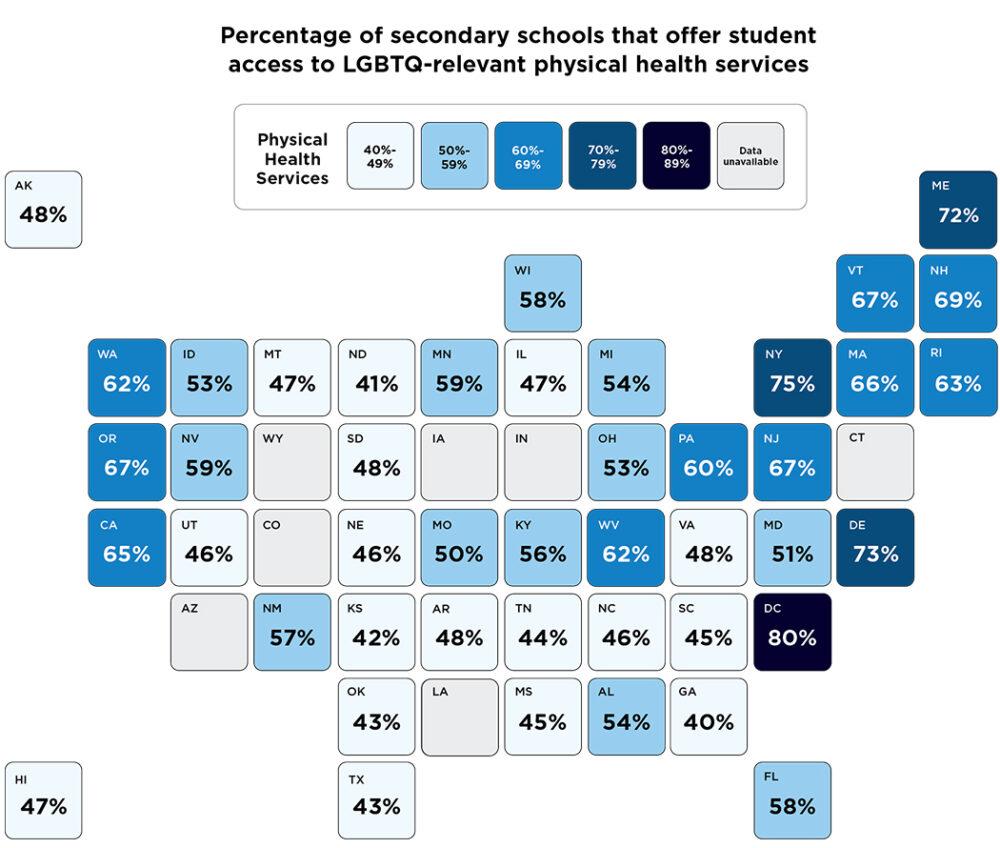State-level Data Show Schools Can Facilitate LGBTQ Students’ Access to Relevant Physical Health Services
According to a new Child Trends analysis, in 2018, at least half of secondary schools in 25 states and the District of Columbia facilitated students’ access to providers not on school property who have experience providing physical health services to lesbian, gay, bisexual, transgender, queer, and/or questioning (LGBTQ) youth (see map below). These findings are derived from the most recently available data from the Centers for Disease Control and Prevention (CDC). The District of Columbia—which we consider equivalent to a state for purposes of comparison—had the highest overall percentage of schools (80%) that facilitate access to providers with expertise in LGBTQ health services, followed by New York (75%), Delaware (73%), and Maine (72%). In 18 states, fewer than half of secondary schools facilitate access to such services. Georgia has the lowest proportion of secondary schools providing such services, at 40 percent of high schools.

Source: Centers for Disease Control and Prevention. (2019). School Health Profiles 2018: Characteristics of Health Programs Among Secondary Schools. Centers for Disease Control and Prevention.
Stigma and discrimination—including policies and laws that restrict access to supports and services based on sexual and gender identities—can lead to unique stressors that place LGBTQ youth at a higher risk for sexually transmitted diseases, cancers, cardiovascular diseases, and obesity, relative to their cisgender, heterosexual peers. Furthermore, LGBTQ youth face additional barriers to accessing physical health care. Such barriers include health care providers without adequate training or education on LGBTQ health needs and poor quality of care due to stigma.
Schools can reduce health inequities experienced by LGBTQ youth by ensuring that youth have access to providers with expertise in addressing their unique needs. Particular attention should be paid to meeting the needs of LGBTQ youth of color, who often experience racism in addition to discrimination based on sexuality—even within LGBTQ-inclusive health care settings. Characteristics of affirming health care include regular training on the unique needs of LGBTQ youth, the use of educational materials—such as posters, brochures, and videos—that are inclusive of LGBTQ youth, gender-neutral bathrooms, and intake forms and protocols that allow youth to share their pronouns and sexual identity to help health providers provide them with appropriate care. Beyond clinical care, school-based health providers should also advocate for efforts to address stigma and discrimination, such as addressing bullying, supporting the establishment of Gender and Sexuality Alliances (GSAs), and requiring instructional materials that address the needs of LGBTQ youth.
Series
- Only 17 States and DC Report LGBTQ-Inclusive Sex Ed Curricula in at Least Half of Schools, Despite Recent Increases
- Only 9 States and DC Report That More Than Half of Secondary Schools Have a Gender and Sexuality Alliance
- Schools Can Reduce Barriers to Mental Health Access by Ensuring That Services Are Supportive of LGBTQ Youth
© Copyright 2024 ChildTrendsPrivacy Statement
Newsletter SignupLinkedInThreadsYouTube